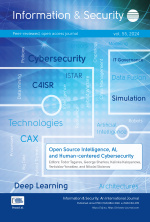Adopting Machine Learning for Images Transferred with LoRaWAN
Source:
Information & Security: An International Journal,Keywords:
cloud, IoT, LoRa, machine learning, Raspberry PI, securityAbstract:
LPWAN (Low-power Wide-area network) networks are well-known since the 1980s, but due to low efficiency were not in active use for a long time. Modern LPWAN is a game-changing technology with true power in net-work coverage, cost efficiency, and low operational expenses. LPWAN services’ most frequent market is in smart cities, agriculture, healthcare, and civil defence systems. LoRa is considered one of the market leaders in LPWAN; however, the low bandwidth of its physical layer makes it unsuitable for high-speed transmission. The provision of integrity, availability, and confidentiality in IoT networks is still of major concern. Data accuracy and lack of control over the transmission of personal information prevents the active use of the technology in regulated industries, such as healthcare and civil defence. In this article, we adopt LoRa for the trans-mission of media content, with an ability to regulate the quality of data and achieve desired level of integrity and availability. This allows the system to self-configure (train) via more reliable machine learning techniques.
